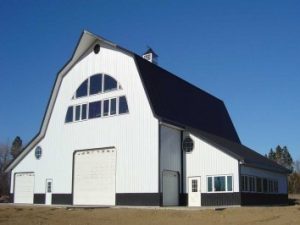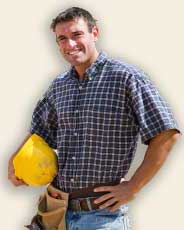Geothermal Heating/Cooling for Post Frame Buildings
I’ve opined upon geothermal heating and cooling for post frame buildings in the past (https://www.hansenpolebuildings.com/2016/12/modern-post-frame-buildings-geothermal/). Reader STEVE in BOYNE CITY had some further questions and writes:
“You said you pump (approx.) 55 degree liquid through pex in ”wells” in the ground (I think is how you put it) through your concrete floor to maintain the slab at that temp. Then you heat the air space above the slab to whatever you want ambient to be. When you said wells did you really mean troughs? More importantly, in hot humid weather, is there a condensation problem on the slab and if so, are ceiling fans used? If the slab is covered with a thin, moderately conductive thermal break like vinyl flooring, how would that affect the temperature moderating effects of the slab? Condensation? Is air conditioning ever needed? PS. I had the idea to do this years ago, and all the older guys in the trades said it was a stupid idea. I am glad you proved it to be a worthy idea.”
When I remodeled what was then my grandparent’s lake cabin outside of Spokane, WA in 1990, I tried to convince my HVAC guy using geothermal wells would be a good idea. Sadly, I let him talk me out of it as I am now (hindsight giving us all 20/20 vision) fully convinced the investment into drilling the wells would have been recouped many times over.
Outdoor temperatures fluctuate with the changing seasons but underground temperatures don’t change as dramatically, thanks to the insulating properties of the earth. Four to six feet below ground (below the frost line), temperatures remain relatively constant year-round. A geothermal system, which typically consists of an indoor handling unit and a buried system of pipes, called an earth loop, and/or a pump to reinjection well, capitalizes on these constant temperatures to provide “free” energy.
 The pipes which make up an earth loop are usually made of polyethylene (PEX) and can be buried under the ground horizontally or vertically, depending on the characteristics of the site. In the case of our 2004 pole building in SD, the loops are buried vertically, hence wells.
The pipes which make up an earth loop are usually made of polyethylene (PEX) and can be buried under the ground horizontally or vertically, depending on the characteristics of the site. In the case of our 2004 pole building in SD, the loops are buried vertically, hence wells.
In winter, fluid circulating through the system’s earth loop or well absorbs stored heat from the ground and carries it indoors. The indoor unit compresses the heat to a higher temperature and distributes it throughout the building, as if it were an air conditioner running in reverse. In summer, the geothermal HVAC system pulls heat from the building and carries it through the earth loop/pump to reinjection well, where it deposits the heat into the cooler earth/aquifer.
The airspace above the slab is heated by the compressed heated liquid running through the pex tubes, although in spaces designed to be offices, the bathroom and kitchenette, they are heated by forced air (where heating/cooling is also generated by the same process as heating/cooling for the slab). We live where it can be 100 degrees and 100% humidity in August and have never experienced condensation on the slab. This could be due, in part, to having a well sealed vapor barrier underneath the concrete slab.
Stone, tile, wood and vinyl are fairly good conductors of heat and do not present any special design considerations. Carpeting may require more temperature from below to allow the heat through.
For more answers on radiant in floor heat, we recommend contacting Les Graham at Radiant Outfitters www.radiantoutfitters.com.









I am interested in using a geothermal setup to heat and cool my pole barn, but can’t seem to get any specifics. I contacted several people, including Les, and no one has direct experience with the cooling aspect of the system. Can you share the deatails of your setup? For example, what type of indoor unit do you use and what is the ratio of tubing in terms of length of pex in the slab compared to the amount of pex in your wells?
I wish I had more information for you, but I relied upon the experts. The folks who have been working on our system are GeoThermal Solutions https://gsibiz.com/ who might be able to give you some ideas.